Engineering
Vol. 3 No. 11 (2011) , Article ID: 8665 , 5 pages DOI:10.4236/eng.2011.311141
Study on Performance and Emission Characteristics of a Compression Ignition Engine Fueled with Diesel-2 Ethoxy Ethyl Acetate Blends
1Department of Mechanical Engineering, Adhiparasakthi Engineering College, Melmaruvathur, India
2Department of Mechanical Engineering, Priyadarshini Engineering College, Vaniyambadi, India
E-mail: babudeepan@gmail.com
Received October 15, 2011; revised November 1, 2011; accepted November 8, 2011
Keywords: 2 Ethoxy Ethyl Acetate, Diesel, performance, emission, compression ignition engine
ABSTRACT
Diesel engines are the major contributors of various types of air polluting gases like carbon monoxide, oxides of nitrogen, smoke, etc. Improvement of fuel properties is essential for suppression of Diesel pollutant emissions along with the optimization of design factors and after treatment equipment. Studies conducted in the past have shown that a significant reduction were obtained in the emissions using oxygenates. This paper investigates the performance and emission characteristics of a direct injection Diesel engine fueled with 2 Ethoxy Ethyl Acetate (EEA) blends. Different fuel blends which contain 5%, 10% and 15% of EEA were prepared and the effect of these blends on performance and emissions were studied on a single cylinder direct injection Diesel engine. The blends were tested under different load conditions and the result showed that EEA blended fuels improves the performance of the engine and reduce the emission level significantly.
1. Introduction
Diesel engines are widely used for transportation and agriculture applications due to their reliability, durability and high thermal efficiency. However, there are two major challenges facing the use of Diesel engines. One is related with fossil fuel sustainability and other is related with environmental concern on engine emissions. Sofar, Diesel engines have adapted many technical breakthroughs for reducing both fuel consumption and pollutant emissions [1].
A number of experimental investigations have been reported with a wide variety of oxygenated additives to improve the fuel properties and engine performance and to reduce emissions. Some of these studies suggested that improvement in particulate emission is directly related to the oxygen content in the blended fuel [2,3]. Ren et al. [4] investigated the effect of di-methoxy methane (DMM) blended with Diesel fuel on performance and exhaust emissions in a compression ignition engine and found that remarkable reduction in CO and smoke were achieved when operated with Diesel/DMM blends. The 5% addition of DMM with Diesel gives better thermal efficiency and reduced engine emissions.
Yanfeng et al. [5] used 2 methoxy ethyl acetate in a direct injection Diesel engine and reported that addition of 15% MEA in Diesel gives 50% - 60% reduction in smoke. The CO and HC emissions also decrease with increase of MEA in the blends. MEA blends produce shorter combustion duration and increased engine thermal efficiency. Husnawan et al. [6] investigated the use of oxygenated and metal based additive in bioDieselDiesel blends in a four stroke Diesel engine and reported that the additive blended fuels produce reduced exhaust emissions as compared with fuels without additive.
Sorenson et al. [7] studied the performance and emission characteristics of DI Diesel engine using dimethyl ether (DME) and found that engines produce ultra-low emissions. However there are some disadvantages in the DME fuel, including reduced viscosity, reduced lubricity and vapour block for its low low boiling temperature. Ball et al. [8] studied the effect of dimethoxy methane additive on Diesel engine particulate matter emission and found that the addition of additive causes a shift in particulate matter size distribution to smaller diameters and substantial particulate matter reduction. The NOx emission does not changed with dimethoxy methane addition. Liu et al. [9-16] carried out experimental work on the effect of DMM blended with gas-to-liquid s in a CI engine and found that the particulate matter and smoke emissions were reduced with an increase of oxygen content in the fuel.
The objective of this study is to investigate the performance and emission characteristics of a direct injection Diesel engine using 2 Ethoxy Ethyl Acetate blended Diesel.
2. Engine Fuel Properties
The fuels used for the experimental analysis were Diesel and three kinds of Diesel-EEA blends. The blended fuels contain 5%, 10% and 15% of EEA in the Diesel by volume. The properties of Diesel, EEA and their blends were given in table 1. From the properties, we can found that EEA has high oxygen content while the calorific value is lower than the Diesel fuel.
Figure 1 and 2 shows the oxygen mass fraction and calorific value of Diesel-EEA blends respectively with respect to the volume fraction. The oxygen content in the fuel increases and the calorific value decreases with increase in the EEA addition.
3. Experimental Setup
Experiments were carried out in a naturally aspirated, single cylinder four stroke, water cooled direct injection Diesel engine. The specifications of the test engine are listed in table 2 and the experi-mental set up is shown in figure 3.
In this study, the engine was operated at a constant speed of 1500 rpm. The series of tests were carried out using Diesel and EEA blends. The performance was measured by eddy current dynamometer. The exhaust gas emissions were measured by AVL gas analyzer and the smoke intensity is measured by Bosch smoke meter.
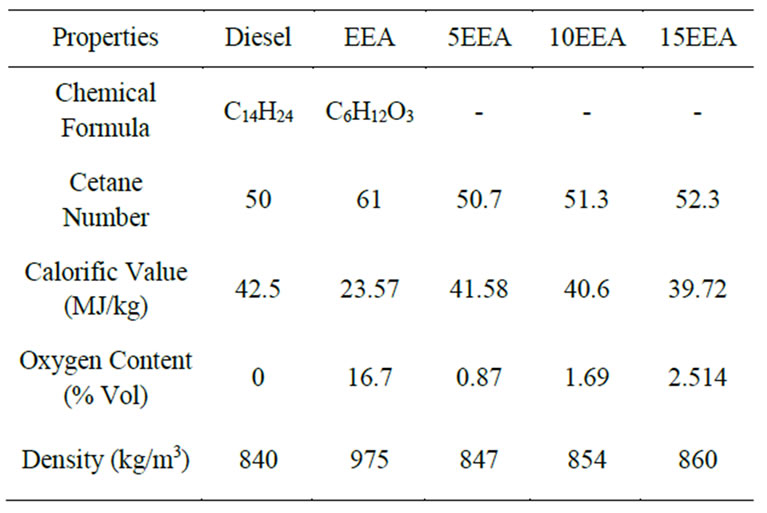
Table 1. Properties of fuels.

Figure 1. Oxygen mass fraction in fuel blends.
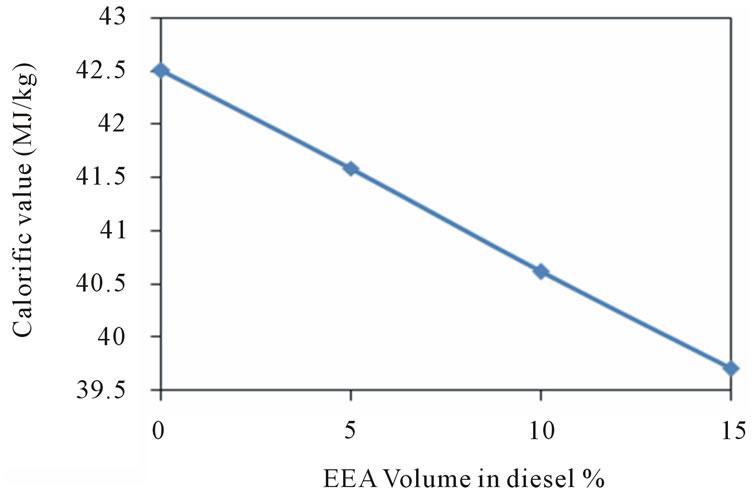
Figure 2. Calorific value of blended fuels.

Figure 3. Experimental setup.
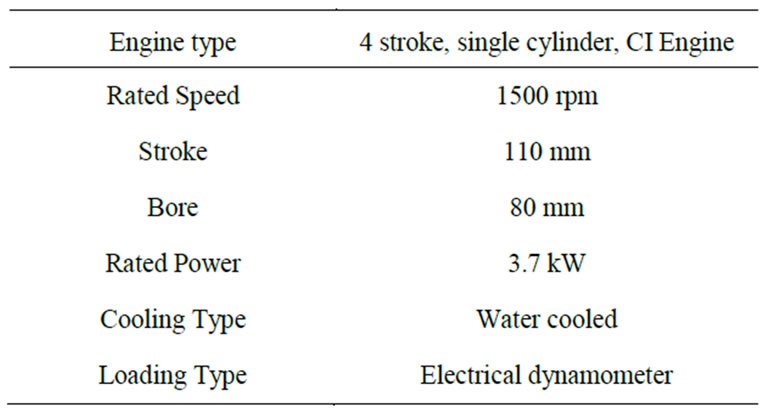
Table 2. Eddy current dynamometer.
4. Results and Discussions
Figure 4 shows the brake thermal efficiency (BTE) variation with respect to load for Diesel and EEA blends. The brake thermal efficiency increases with increase in EEA percentage. At full load condition, the 5%, 10% and 15% EEA blends produce 4.81%, 6.88% and 8.21% higher brake thermal efficiency than sole Diesel respectively. The improvement is due to increase in constant volume combustion and the larger increase of molecules by fuel injection, which leads to better combustion efficiency especially at higher loads.
The variation of exhaust gas temperature (EGT) with respect to load is shown in figure 5. The presence of additional oxygen in the blends always increases the possibility of burning the carbon particles in the exhaust gases which resulted in higher exhaust gas temperature and it also increases with the increase in percentage of blends in the base fuel. At maximum load condition, 15 EEA blend produce 15.51% higher exhaust gas temperature than sole Diesel.
Figure 6 shows the variation of carbon monoxide (CO) emission with respect to load. The 15% EEA blended fuel emits lowest CO emission than other test fuels. At
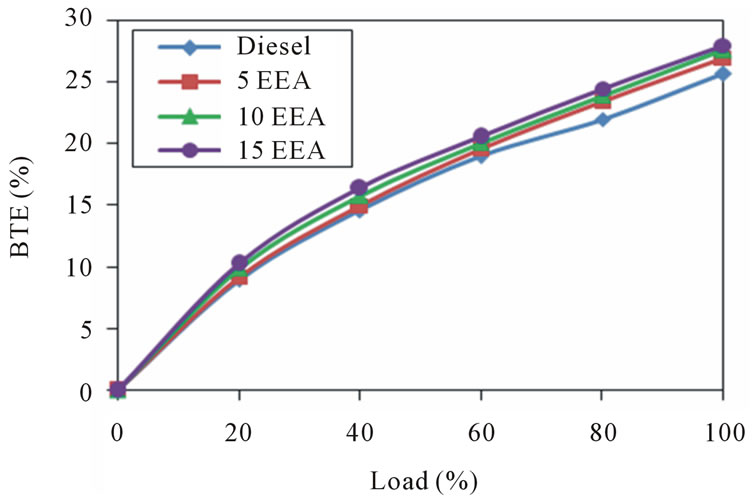
Figure 4. Brake thermal efficiency vs. Load.
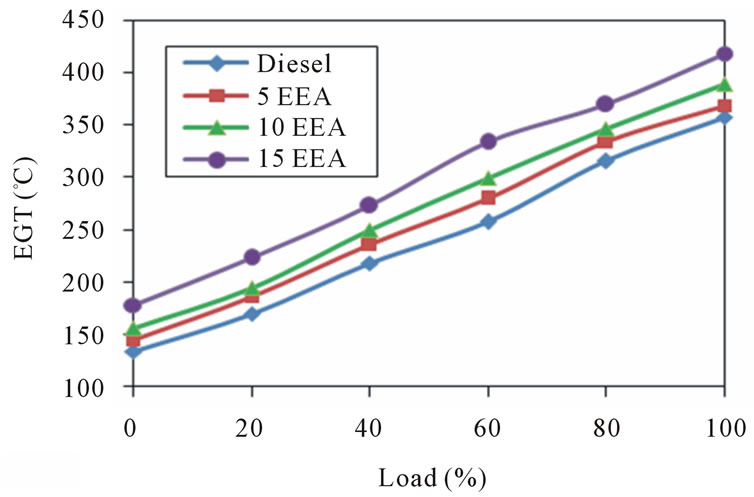
Figure 5. Exhaust gas temperature vs. Load.
full load condition 15 EEA emits 25.6% lower CO emission than that of Diesel. This is due to the presence of more oxygen content in EEA which makes better combustion resulting reduced CO emission.
Figure 7 shows the variation of HC emission with load for Diesel and EEA blended fuels. It was observed that, the 15% EEA blend produce lower HC emission compared to all the test fuels. At full load condition 15 EEA emits 17.8% lower HC emission than that of Diesel. At the same load, the 5% and 10% EEA blends produce 7.38% and 11.94% lower HC emission than Diesel. This reveals that the HC emission tends to reduce as the oxygen content of fuel increases.
Figure 8 shows the variation of oxides of nitrogen (NOx) in the exhaust with respect to load. From the figure, it was observed that 15% EEA blended fuel produce higher NOx emission. The NOx emission increased by 23.8% at maximum load compared to sole Diesel. The more oxygen content in EEA makes combustion better, high peak temperature which results increased in oxides of nitrogen emission.
Figure 9 shows the variation of smoke intensity with respect to load. The Diesel fuel produce highest smoke compared to EEA blended fuels. Compared to sole Die-

Figure 6. Carbon monoxide vs. Load.
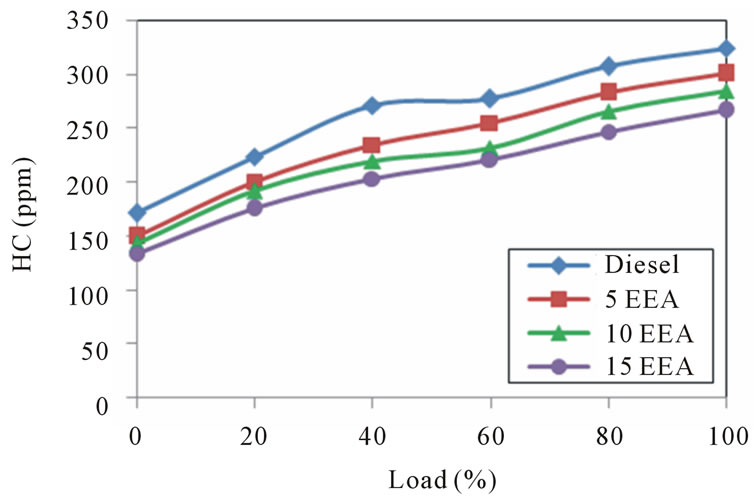
Figure 7. Unburned hydrocarbon vs. Load.
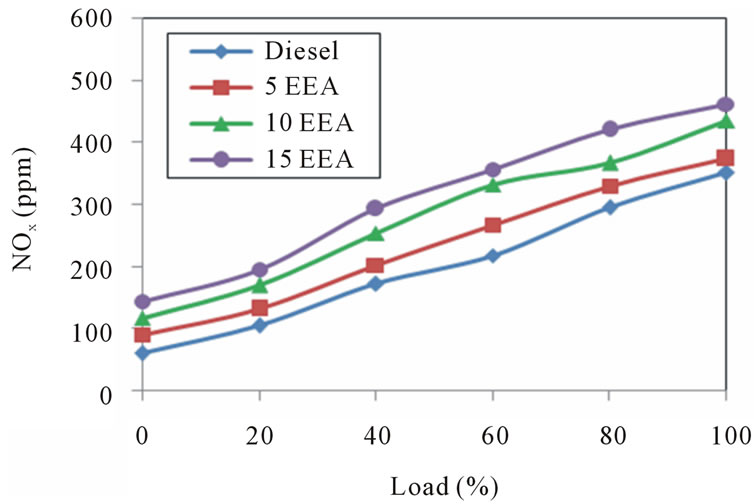
Figure 8. Oxides of nitrogen vs. Load.
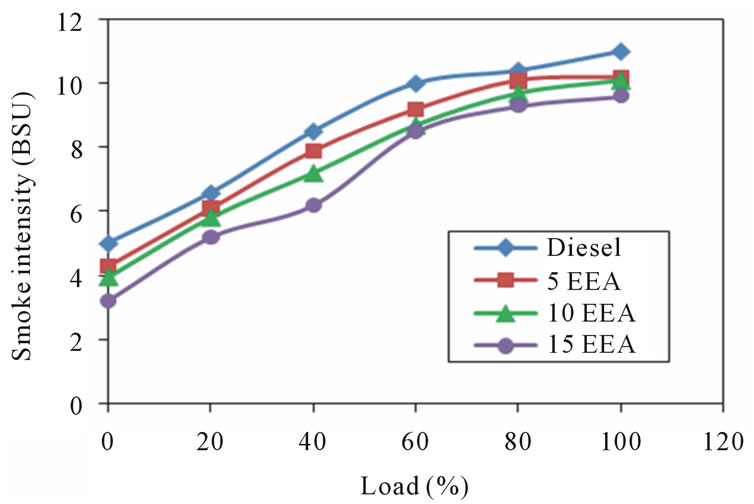
Figure 9. Smoke intensity vs. Load.
sel fuel, the 5%, 10% and 15% EEA blended Diesel produce 7.2%, 8.18% and 12.72% less smoke emission at maximum load. The reduction in smoke is mainly due to the presence of oxygen content in the EEA.
5. Conclusions
The performance and emission characteristics of a single cylinder, four stroke Diesel engine fueled with DieselEEA blends were investigated. The results are summarized as follows.
• By using the blends of Diesel and 2 Ethoxy Ethyl Acetate, the emissions were reduced and simultaneous improvement in the brake thermal efficiency was seen.
• The addition of oxygenated compounds increases the amount of oxygen required for combustion and thereby reduces the HC and CO content in the exhaust gas. Because, the increase of oxygen content in the fuel helps to make the combustion better and complete.
• Due to Complete combustion, the peak temperature was increased. Due to this increased peak combustion temperature the formation of NOx is more.
• A good reduction in smoke level was achieved from the 2 Ethoxy Ethyl Acetate blends compared to the neat Diesel fuel.
6. REFERENCES
- R. J. Zhu, X. B. Wang, H. Y. Miao, X. F. Yang and Z. H. Huang, “Effect of Dimethoxy Methane and Exhaust Gas Recirculation on Combustion and Emission Characteristics of a Direct Injection Diesel Engine,” Fuel, Vol. 90, No. 5, 2011, pp. 1731-1737. doi:10.1016/j.fuel.2011.01.035
- Y. Akasaka and Y. Sakurai, “Effect of Oxygenated Fuel on Exhaust Emission from DI Diesel Engines,” JSME Transactions, Vol. 63, No. 609, 1996, pp. 1833-1899. doi:10.1299/kikaib.63.1833
- C. S. Cheung, R. J. Zhu and Z. H. Huang, “Investigation on the Gaseous and Particulate Emissions of a Compression Ignition Engine Fueled with Diesel-Dimethyl Carbonate Blends,” Science of the Total Environment, Vol. 409, No. 3, 2011, pp. 523-529. doi:10.1016/j.scitotenv.2010.10.027
- Y. Ren, Z. H. Huang, D. M. Jiang, L. X. Liu, K. Zeng, B. Liu and X. B. Wang, “Engine Performance and Emission Characteristics of a Compression Ignition Engine Fuelled with Diesel/Dimethoxy Methane Blends,” Proceedings of IMechE, Part D: Journal of Automobile Engineering, Vol. 219, 2005, pp. 905-914. doi:10.1243/095440705X28367
- Y. F. Gong, S. H. Liu, H. J. Guo, T. G. Hu and L. B. Zhou, “A New Diesel Oxygenate Additive and Its Effects on Engine Combustion and Emissions,” Applied Thermal Engineering, Vol. 27, No. 1, 2007, pp. 202-207. doi:10.1016/j.applthermaleng.2006.04.021
- M. Husnawan, H. H. Masjuki, T. M. I. Mahlia, S. Mekhilef and M. G. Saifullah, “Use of Post Flame MetalBased and Oxygenated Additive Combination for Biodiesel-Diesel Blends,” Journal of Scientific and Industrial Research, Vol. 68, 2009, pp. 1049-1052.
- S. C. Sorenson and S. E. Mikkelsen, “Performance and Emissions of a 0.2731 Direct Injection Diesel Engine Fueled with Neat Dimethyl Ether,” SAE Transactions, Vol. 104, 1995, pp. 80-90.
- J. C. Ball, M. A. Gonzalez, C. Lapin and E. Linley, “Dimethoxy Methane in Diesel Fuel,” SAE Paper No. 2001- 01-3627.
- W. Liu, Z. H. Haung, J. S. Wang, X. Q. Qiao and J. X. Hau, “Effects of Dimethoxy Methane Blended with Gasto-Liquids on Particulate Matter Emissions from a Compression Ignition Engine,” Energy Fuel, Vol. 22, 2008, pp. 2307-2313. doi:10.1021/ef700735c
- W. Momani, S. Abu-Ein, M. Momani and S. M. Fayyad, “Effects of Oxygenated Gasoline on Fuel and Air Mass Flow Rates and Air Fuel Ratio,” American Journal of Applied Sciences, Vol. 6, 2009, pp. 974-977. doi:10.3844/ajassp.2009.974.977
- N. Miyamoto and H. Ogawa, T. Arima, “Improvement of Diesel Combustion and Emissions with Addition of Various Oxygenated Agents to Diesel Fuels,” SAE Paper No. 962115, 1996.
- I. Ahmed, “Oxygenated Diesel: Emissions and Performance Characteristics of Ethanol-Diesel Blends in CI Engines,” SAE Paper No. 2001-01-2474, 2001.
- T. Nibin, A. P. Sathiyagnanam, S. Sivaprakasam and C. G. Saravanan, “Investigation on Emission Characteristics of a Diesel Engine Using Oxygenated Fuel Additive,” Journal of Institution of Engineers (India), Vol. 86, 2005, pp. 51-54.
- M. N. Nabi, D. Kannan, J. E. Hustad and M. M. Rahman, “Role of Oxygenated Fuel to Reduce Diesel Emissions: A Review,” International Conference on Mechanical Engineering (ICME 2009), Dhaka, Bangladesh, 26-28 December 2009.
- C. Bertolic, “Diesel Combustion Improvements by the Use of Oxygenated Synthetic Fuels,” SAE Paper No. 972972, 1997.
- M. Iranmanesh, J. P. Subrahmanyam and M. K. J. Babu, “Potential of Diethyl Ether as a Blended Supplementary Oxygenated Fuel with Biodiesel to Improve Combustion and Emission Characteristics of Diesel Engines,” SAE Paper No. 2008-01-1805, 2008.
Nomenclature
EEA 2 Ethoxy Ethyl Acetate
BTE Brake thermal efficiency
EGT Exhaust gas temperature
CO Carbon monoxide
HC Unburned hydrocarbons
NOx Oxides of nitrogen
BSU Bosch smoke unit

